Planting trees in spring is a great time to bring your garden to life, and a little preparation during the cooler months can set you up for success. In this guide, we will walk you through everything you need to know about planting and maintaining a healthy, thriving garden.
Take some time before planting to decide what you want to achieve. Proper planning is key, whether you are planting trees for spring blossoms, year-round greenery, or attracting wildlife. Different trees and plants serve different purposes, so understanding your vision will help you to select the right plants for your garden. Here are some popular choices to match your goals:
Spring blossoms: Ornamental cherries, Crab apples or Amelanchiers.
Year-round foliage: Evergreens like Photinia Red Robin or Laurels.
Wildlife attraction: Hawthorn or rowan trees.
Winter interest: Birch trees or other trees with striking bark.
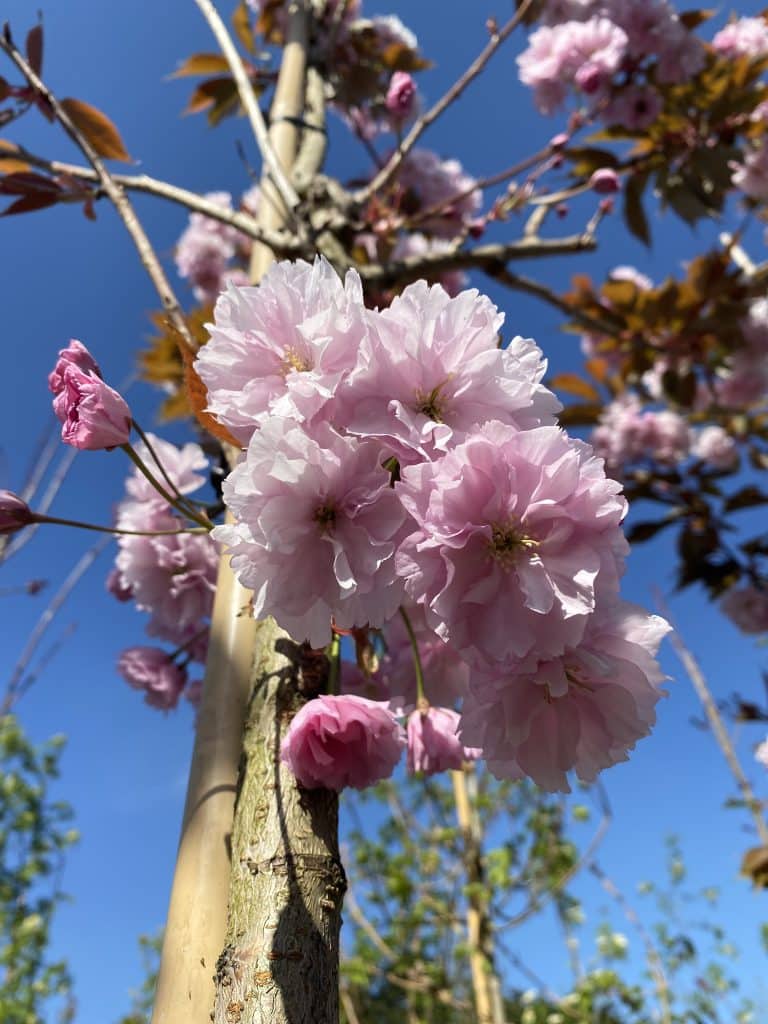
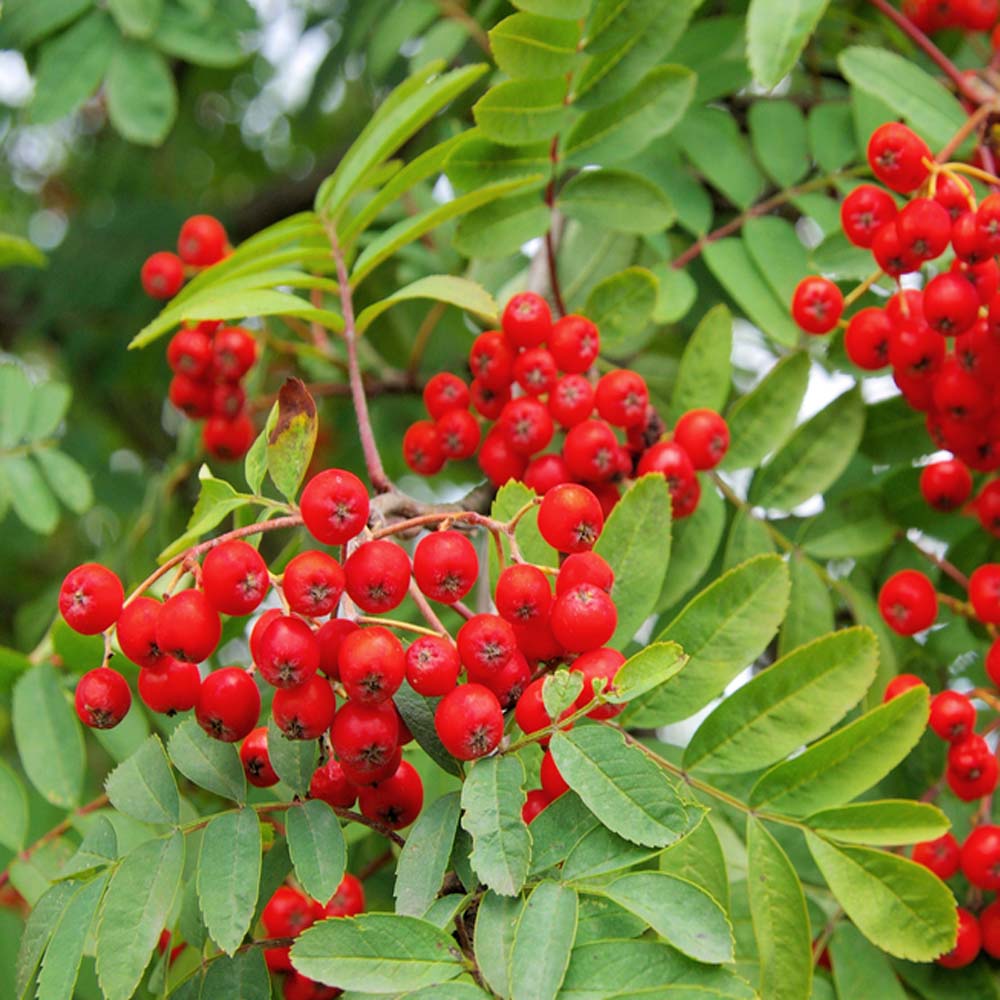
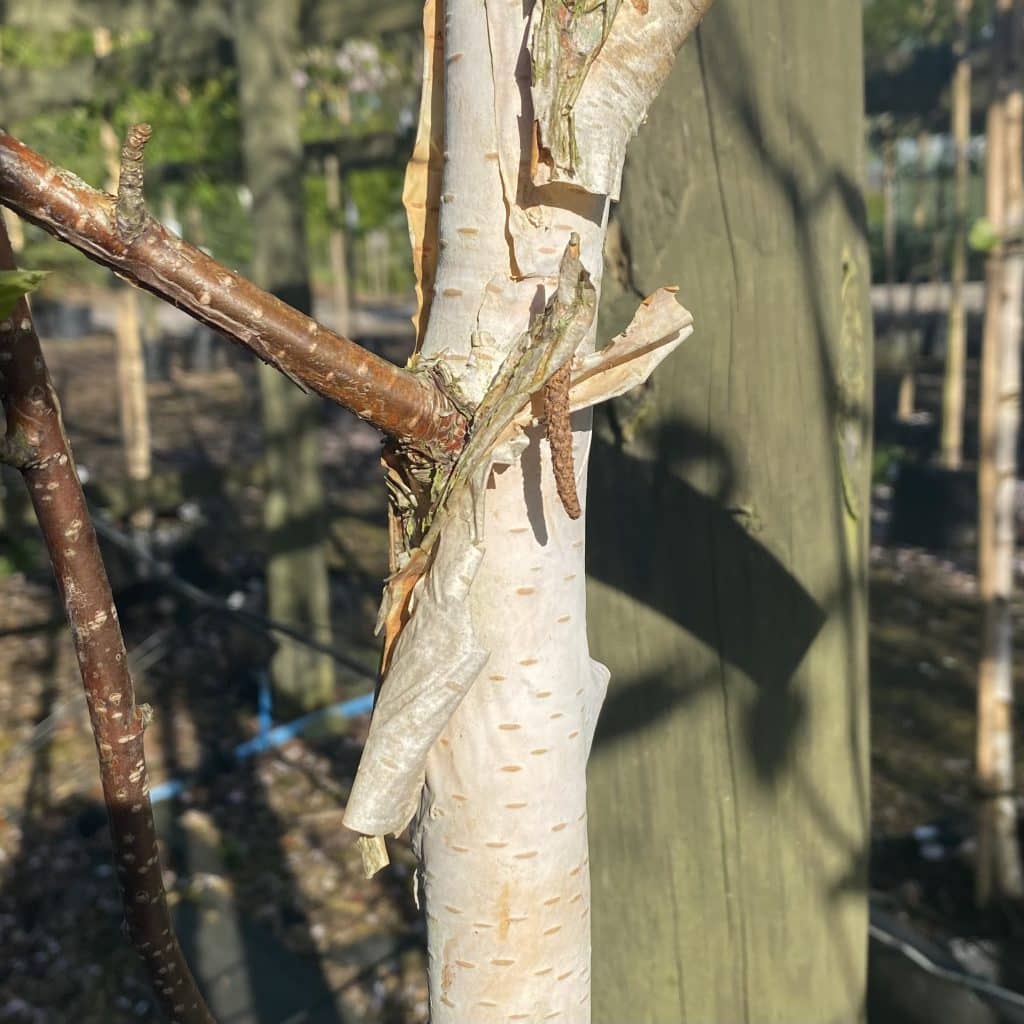
Healthy soil is the foundation of a thriving garden. Start by loosening the soil in your planting area and adding organic matter such as multipurpose compost or well-rotted manure. This enriches the soil with nutrients while preventing compaction, giving your plants the best possible start.
Once you have planted your tree, proper support is essential to help it establish strong roots. Depending on your garden’s conditions and the size of your tree, choose one of the following staking methods:
Sheltered locations: A single stake will usually suffice.
Exposed areas or larger trees: Use two stakes for added stability.
To give your newly planted tree the best possible start, we offer a range of tree planting kits. Our selection includes the Value, Heavy Duty, Irrigated, Nutrient, and Premium kits, each tailored to different needs and environments. For more information about each option, check out out our article on the planting kits we can supply! For a video planting guide check out the video below…
The secret to a thriving garden lies in consistent care. Here are three essential maintenance tips to keep your trees healthy:
If planting trees in spring you will need to establish a regular watering schedule as soon as the growing season begins in order to keep the soil moist. You do this for the first few growing seasons…
During the growing season: Start by giving the trees 5 litres of water every second day, directing the water to the base of the trunk. This 5 Litres is a good starting point/guide to make sure that the soil stays moist, if the soil starts to become saturated or dry adjust the amount as required.
During dormancy period (November-March): Pause watering as the ground should be moist enough, just check it over any extended dry periods. Resume regular watering in early spring.
Are you going on holiday or have other commitments that make sticking to the watering schedule difficult? If so, we can supply our King & Co Tree Watering Bags. These bags are an easy to install watering aid that slowly deliver water to the roots and allow more of the water to be absorbed deeper into the soil to promote root establishment.
Pruning encourages healthy growth and keeps your trees looking their best. You can usually trim trees twice a year…
After flowering (late spring/early summer): Help the trees to thicken and grow more branches.
Early September: Tidies up the plant to create a nice, even shape for new growth in spring.
Keep a 1m weed-free circle around the base of each tree to minimize competition for nutrients and moisture. To further protect your trees, you can apply a thin layer of mulch around the base. Mulch helps suppress weeds, retain moisture, and regulate soil temperatures. Just avoid piling mulch against the trunk as this can trap moisture and lead to rot.
Creating a thriving garden takes time, effort, and careful planning, but the results are well worth it. By defining your goals, preparing your soil, and following a consistent care routine, you will set your garden up for success and enjoy its beauty throughout the seasons.
Get started today and watch your garden flourish into a vibrant, thriving haven!
Bare root trees can be planted from November to March. Container grown trees can be planted all year round. Watch our video guide on how to do so.
As a guide, we recommend giving each tree 5 litres of water every other day during the growing season. The water should be directed at the base of the trunk.
5 Litres is a good starting point to make sure that the ground stays moist, if the soil starts to become saturated or dry adjust the amount as required.
We can offer our planting service if you are local to the nursery. Planting prices are dependent on the size of the pot. Please contact us if you would like a quote.
Fruit trees are an excellent choice for gardeners who want to grow delicious fruit whilst supporting wildlife and adding seasonal beauty to their garden. From the months of November to March, we stock a range of bare root fruit trees that are lifted while dormant and sold without soil around their roots. Once the dormancy period, we pot on any of our left of bare root stock so that they can develop roots before they are planted. This container grown stock is usually available around June once the roots have had time to settle.
At King & Co we offer a variety of Apples, Cherries, Pears and Plums. If you want to grow your own fruit and transform your garden, have a look at our guide on some of our best-loved fruit trees…
Apple trees are a popular choice for new and experienced gardens as they are versatile and easy to grow. All the apples we supply are grown on MM106 rootstocks to produce strong trees, that reach a mature height of 5-6m and a mature spread of 4-5m. Some of our favourite varieties include…
Bramley: Classic cooking apples, perfect for pies and sauces.
Cox: Aromatic apples with a sweet-tart flavour.
James Grieve: Tangy apples, great for eating fresh or cooking.
Cherry trees are a rewarding addition any garden owing to their delicious fruits, beautiful blossoms and attraction to wildlife. Grown on Colt rootstocks to produce strong, healthy trees that reach mature heights of 5-6m, our favourite cherries are…
Morello: Tart cherries, ideal for cooking and preserves.
Stella: Sweet, self-fertile cherries variety perfect for snacking.
Sunburst: Large, juicy cherries with a sweet taste.
Pears are low maintenance fruit trees with attractive spring blossoms and colourful autumn foliage. Grown on a Quince A rootstock our pear trees will reach a mature height of 5-6m. Our two favourite varieties are…
Comice: Sweet, juicy pears ideal for desserts and fresh eating.
Conference: Reliable pears that are crisp and aromatic.
Plum trees are great for those who want to add beauty to their garden whilst enjoy the delicious, versatile fruits that are produced. A must-have for any garden, the Victoria Plum produces sweet, juicy fruit that is perfect for eating fresh, making jams, or baking into desserts. Grown on a St Julien A rootstock, Victoria plum reaches a mature height of 4-6m.

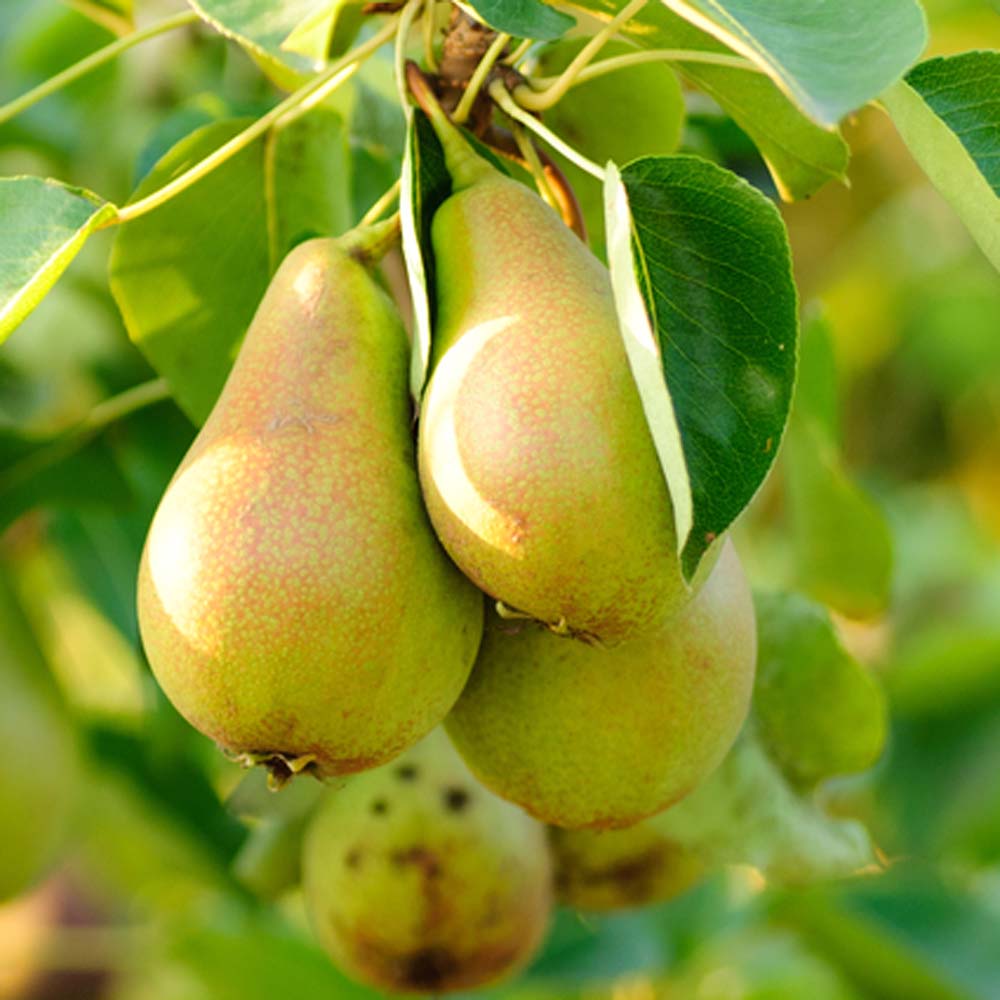
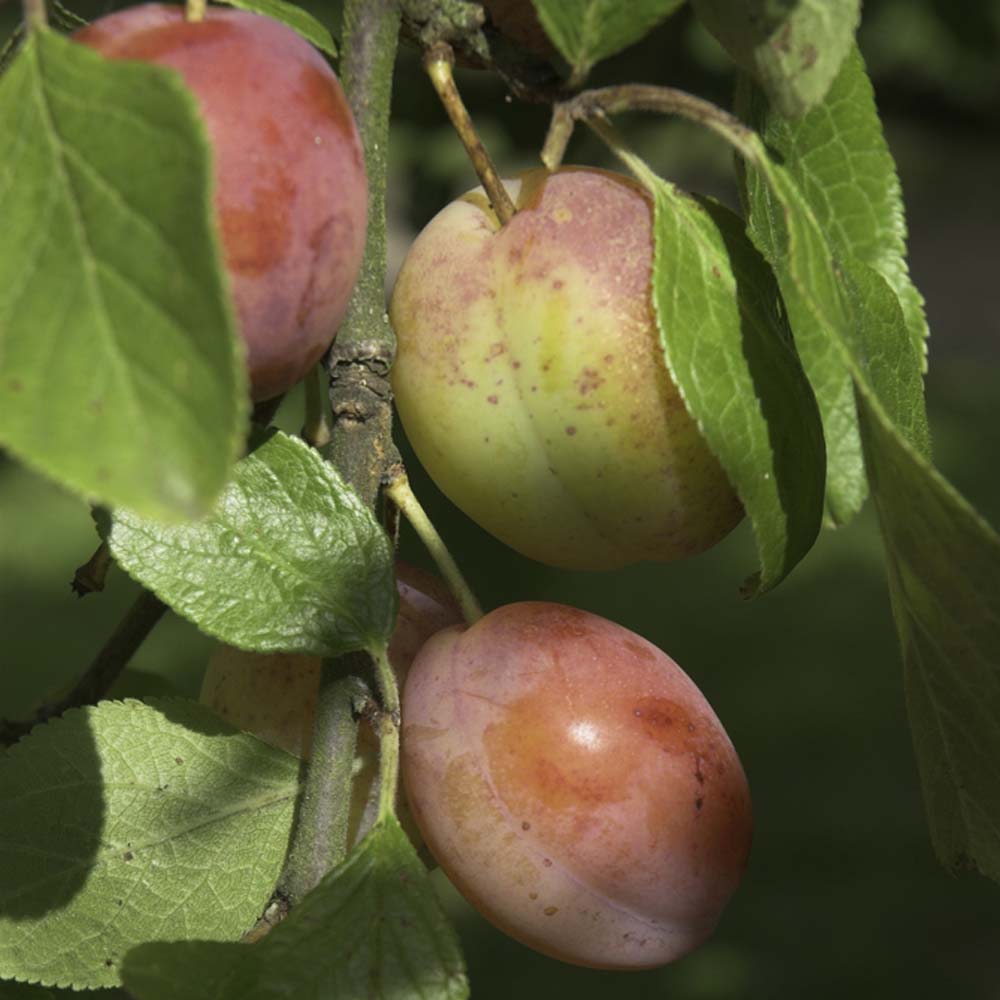
In short, planting Apple, Cherry, Pear and Plum trees is an excellent and rewarding way to enhance your garden while enjoying fresh, home-grown produce. Follow these tips to achieve healthy harvests…
Pollination – Some fruit trees, like cherries and apples, benefit from cross-pollination. Plant compatible varieties nearby to ensure a larger harvest.
Thinning Fruit – Remove some developing fruit to prevent overloading the tree, which can lead to smaller fruit or weakened branches.
Harvest Timing – Apples like Cox and Braeburn are best picked when firm and fragrant, Pears such as Comice and Conference should be harvested slightly under ripe and ripened indoors and Victoria plums are ready when they have deep purple skin and feel slightly soft.
During the first year of planting, it is also recommended to remove any fruit from the trees. Doing this will help to promote root development, as it helps the tree to focus its energy on establishing strong roots rather than producing fruit.
Bare root trees can be planted from November to March. Container grown trees can be planted all year round. Watch our video guide on how to do so.
As a guide, we recommend giving each tree 5 litres of water every other day during the growing season. The water should be directed at the base of the trunk.
5 Litres is a good starting point to make sure that the ground stays moist, if the soil starts to become saturated or dry adjust the amount as required.
We can offer our planting service if you are local to the nursery. Planting prices are dependent on the size of the pot. Please contact us if you would like a quote.

Yes, pleached trees are good for screening and they are very popular for achieving immediate privacy in outdoor areas!
Their effectiveness comes from the fact that their foliage has been grown over several years to fully cover a trellis frame. This article delves into what pleached trees are, highlights the advantages of planting them, and demonstrates how they can provide instant coverage!
Pleached trees have a clear stem and branches trained onto a flat framework. Known for their instant screening effect, they are an excellent way to create a raised hedge above the fence line.
Year-round Privacy – All of our pleached trees will hold onto their leaves throughout the winter months to provide year round coverage (even Hornbeam holds onto its crispy brown leaves).
Saving Space – With branches tied onto the supporting frame, pleached trees are an excellent option for smaller gardens or tight spaces.
Architectural Planting – Great for adding structure to gardens, they are the perfect choice for contemporary or formal gardens.
Planting a screen of pleached trees requires careful planning. Before planting, make sure that you:
Choose the right trees for your garden and needs. If you are looking for year round coverage, then you could consider an evergreen like Photinia Red Robin on Cherry laurel (Prunus laurocerasus). If natural light in the winter months is important, then a deciduous variety like Hornbeam may be better. Although Hornbeam are deciduous they hold onto their brown leaves long through the winter, this allows light to pass through the branches whilst maintaining some coverage.
Measure the area that needs to be screened. Measuring before planting means that you can space the trees out evenly along your boundary to create a seamless, uninterrupted screen. You typically space pleached trees 1.2-1.5m apart, depending on the size of their frame.
Get all the equipment needed for planting. Pleached trees need to be staked and tied throughout the early stages of establishment. Watch our video guide on how to professionally plant and stake your tree!
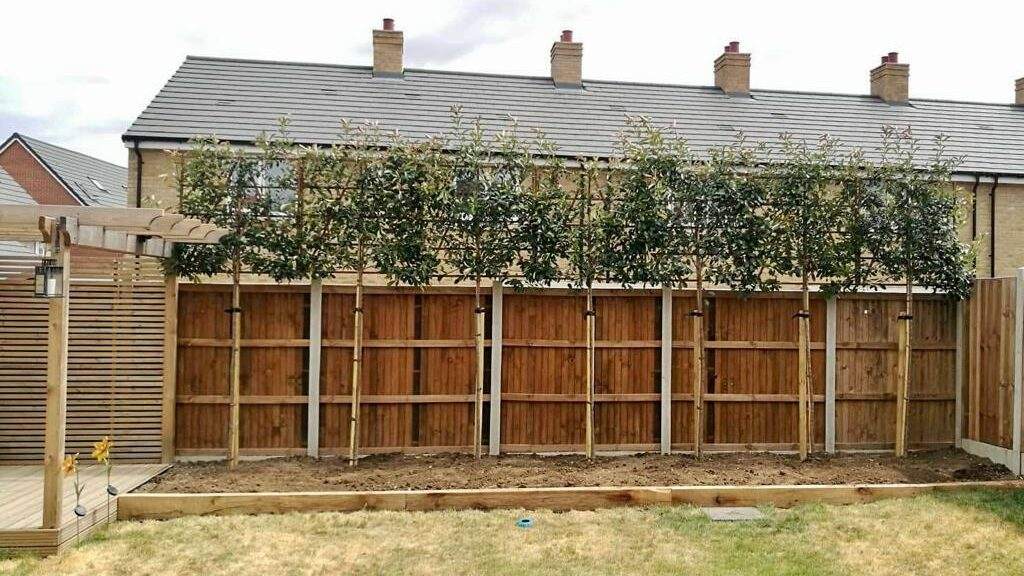
We hope this article helped to show why pleached trees are good for screening. If you require any guidance on selecting the right varieties or quantities, or if you’d like to discuss the suitability of pleached trees for your specific needs, please don’t hesitate to contact our sales team or visit us at the nursery. We’re always happy to help!
Container grown trees can be planted all year round. Watch our video guide on how to do so.
As a guide, we recommend giving each tree 5 litres of water every other day during the growing season. The water should be directed at the base of the trunk.
5 Litres is a good starting point to make sure that the ground stays moist, if the soil starts to become saturated or dry adjust the amount as required.
We can offer our planting service if you are local to the nursery. Planting prices are dependent on the size of the pot. Please contact us if you would like a quote.
Ideal for natural screening in overlooked gardens, Ilex castaneifolia (Chestnut Leaf holly) is an evergreen tree with dense foliage. The key features of this Holly tree are its…
1. Foliage. Ilex castaneifolia has serrated, chestnut-like leaves. These glossy leaves are unusually large for a holly and resemble Sweet chestnut (hence the name). This dense foliage offers a natural solution to privacy by providing gardens with year round coverage.
2. Versatility. The dense, pyramidal crown of the Chestnut Leaf holly means that it can be used as a specimen or screen in any sized garden.
3. Growth rate and maintenance. Reaching an eventual height of around 8m+/-, Ilex castaneifolia has a moderate growth which means that it is low maintenance and easy to manage.
4. Hardiness. The Chestnut Leaf holly is a hardy tree that tolerates all but waterlogged soils.
Container grown trees can be planted all year round. Watch our video guide on how to do so.
As a guide, we recommend giving each tree 5 litres of water every other day during the growing season. The water should be directed at the base of the trunk.
5 Litres is a good starting point to make sure that the ground stays moist, if the soil starts to become saturated or dry adjust the amount as required.
We can offer our planting service if you are local to the nursery. Planting prices are dependent on the size of the pot. Please contact us if you would like a quote.
The documentary is aimed to help open the eyes of the many steps involved in the plant trade where plant health is concerned and the professionalism behind it. King and Co are Plant Healthy and UKISG assured in addition to being members of the HTA.
Recordings took place at docks, ports, BCPs, Defra diagnostic lab in York and King and Co to show the steps to keep the UK safe from plant pests and diseases.
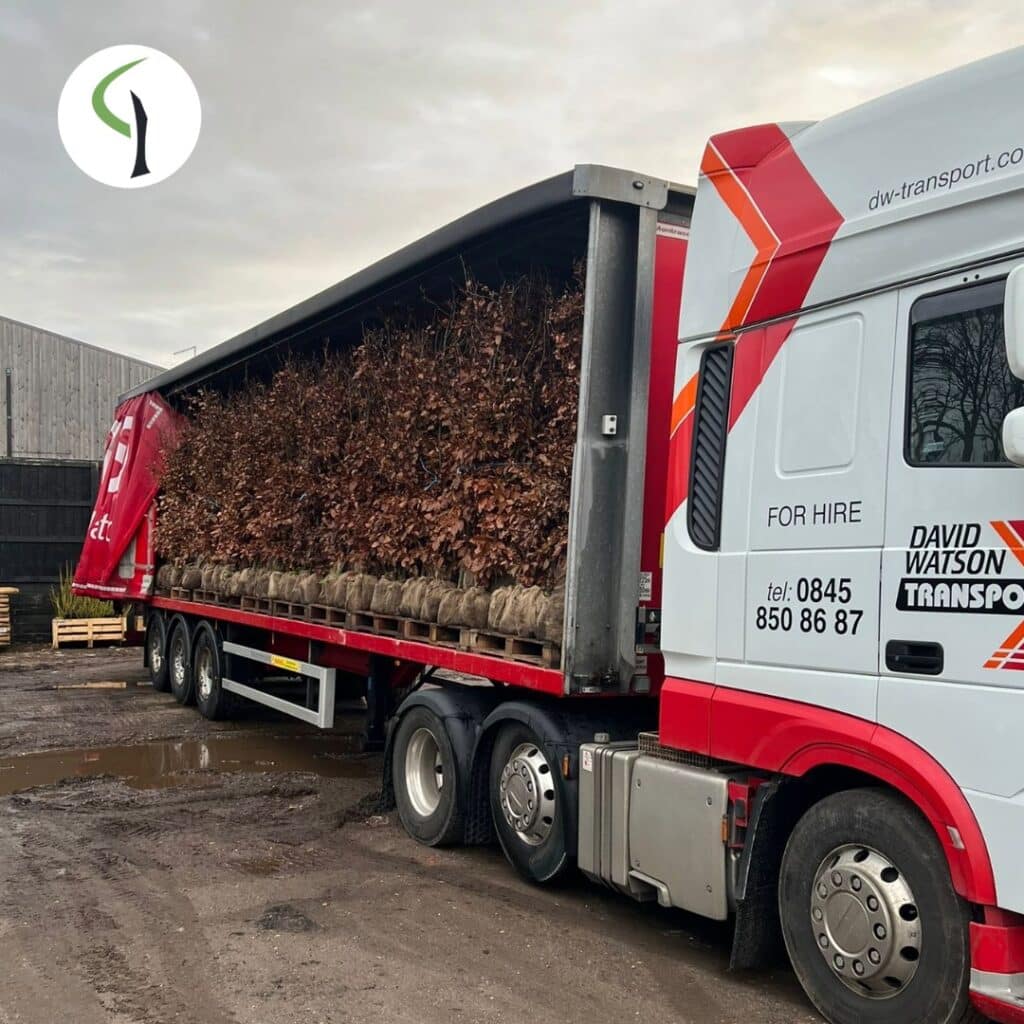
King and Co adhere to a voluntary Plant Healthy standard to ensure best practices are in place. The Plant Healthy standard promotes plant health risk analysis where suppliers and plant handling is concerned. King and Co visit suppliers and tag stock on a regular basis, constantly evaluating the health of stock and growing methods.
The risk of Xylella fastidiosa to the UK is the reason King and Co do not sell Olive trees, which can pose a dangerous threat to trees and plants across the country.
It is important to evaluate the health of trees, plants, growing media, nursery soil and chemical application programme before it enters our own Nursery site. The small percentage of stock (which is imported) is also inspected at inland Border Control Points to again check its health.
King and Co’s Plant Healthy trained staff inspect each tree and plant upon its arrival at the Nursery in its designated quarantine area as another line of defence to Nursery stock. The trees and plants at this point have been checked thoroughly several times. It is only at this point the stock can be released onto the site.
The new stock will now be checked daily in line with King and Co’s Pest Risk Analysis schedule. To ensure traceability, each new batch of plants is assigned its own identification code linking directly to its source. UKISG assurance proves King and Co UK Provenance plants can be traced right back to seed.
Before any trees of plants leave the Nursery, they are checked a final time to make sure again they are in good health. It is only this rigorous checking, by experienced and trained experts, which can truly stop a plant pathogen escaping into the surrounding environment.
Buy responsibly! Plant Healthy suppliers are independently audited to check that the correct procedures are in place to intercept a notifiable pest or disease.
Trees and pants sold by a Supermarket or Homeware store for example may be checked at a central hub or BCP if they are imported, but these are not being checked and handled by qualified and experienced individuals for latent threats to plant health.
BBC Radio 4 – ‘Pipping a Plant Pandemic’
Airs: Wednesday 11th December, 15:30
BBC Radio 4 – Pipping a Plant Pandemic

How to screen with Laurel trees?
Our Laurel standards have clear stems and bushy heads of evergreen foliage that sit above the fence line to enhance privacy without encroaching on the rest of the garden! Perfect for planting in a row to create an uninterrupted screen, you could also strategically plant one tree to block a specific view!
If planting in a row, we recommend planting the trees at 1.2-1.5m centres so that they will grow into each other! Measure the boundary before planting so that you can space the trees out evenly.
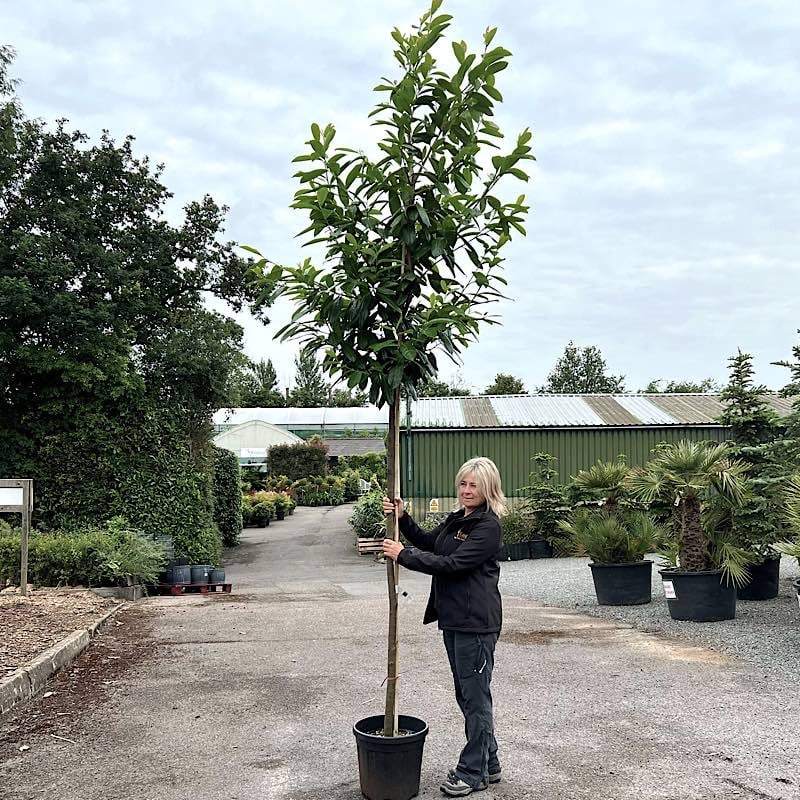
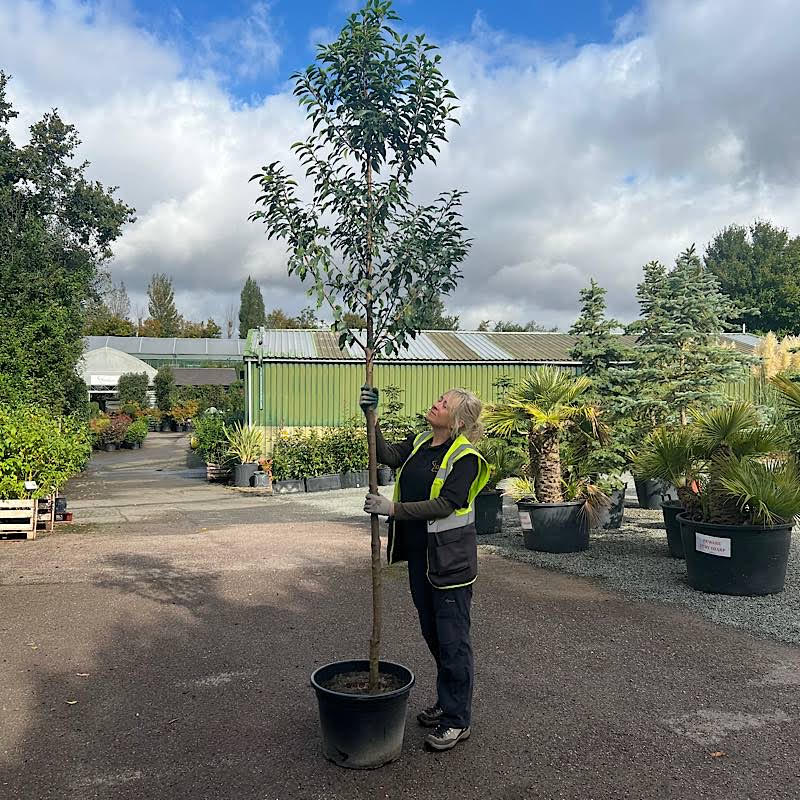
If you prefer a formal appearance, then you could go for a Pleached laurel instead. Known for their instant screening effect, these pleached trees have a clear stem and branches trained onto a flat framework.
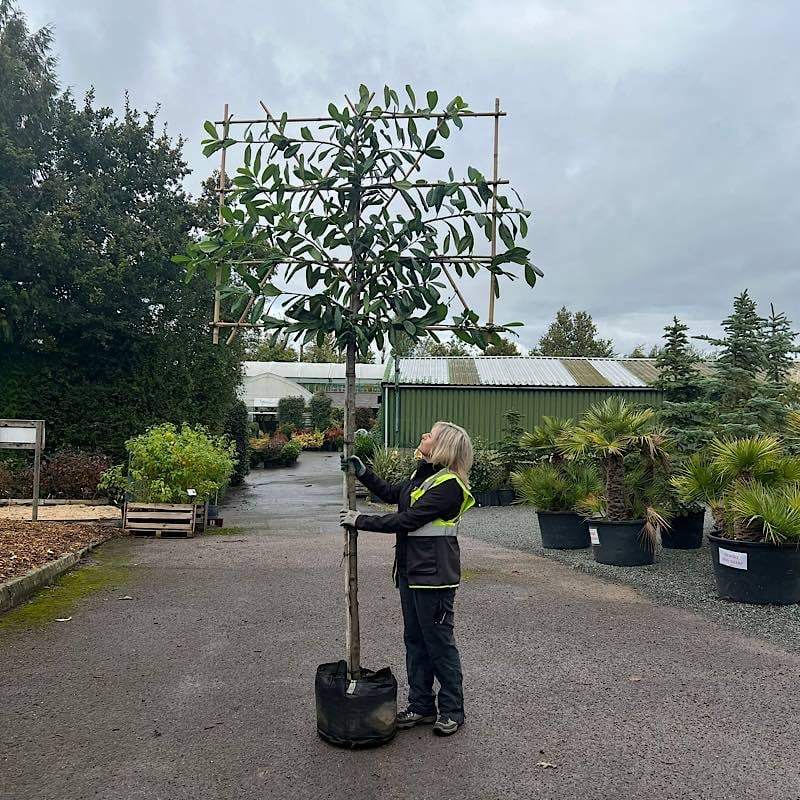
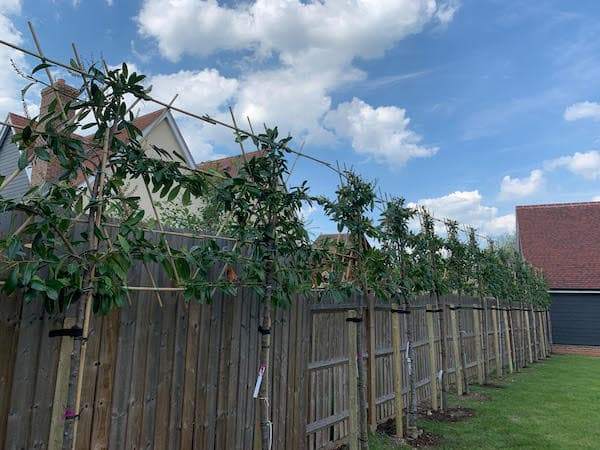
Container grown trees can be planted all year round. Watch our video guide on how to do so.
As a guide, we recommend giving each tree 5 litres of water every other day during the growing season. The water should be directed at the base of the trunk.
5 Litres is a good starting point to make sure that the ground stays moist, if the soil starts to become saturated or dry adjust the amount as required.
We can offer our planting service if you are local to the nursery. Planting prices are dependent on the size of the pot. Please contact us if you would like a quote.
Trees are a vital addition to any landscape, but it is important to consider a species’ mature height, spread and growth rate before planting trees in smaller gardens. Here we have selected our top tree choices for small gardens, each of these species have a compact habit and will provide your landscape with seasonal interest and visual appeal. For alternative suggestions, have a look at the Small Garden Trees category on our website! If you are looking to plant an evergreen/semi-evergreen tree, you could explore our Top 10 Screening Trees for their year round coverage and privacy!
Catalpa bungei is the Dwarf form of the Indian Bean Tree. Grafted onto a 2m stem, this tree will only reach a mature height of around 4-5m which means that it could be a candidate for smaller gardens. Catalpa is a beautiful, distinctive tree with heart-shaped green leaves that form a full, round crown when mature. In hot summers, this tree can also produce scented pink-purple flowers to provide additional interest!
The Flamingo willow is best known for its masses of fuzzy yellow catkins that emerge in early spring and its distinctive lance-shaped leaves. These leaves exhibit a striking variegation of pink, creamy white, and green, gracefully transitioning to a solid green as they mature.
Our half-standard Salix trees have a 1m stem and a crown that typically grows an additional 2 to 2.5 meters above the graft. Perfect for adding height and visual appeal to smaller gardens, you can clip and shape these trees to maintain a neat, compact form. Alternatively, they can be left to grow more freely, developing into a larger, spherical shape or an attractive small tree.
Photinia Red Robin is a fast-growing, evergreen plant with young foliage that emerges as red and mature to green, in spring an abundance of cream-white flowers also appear. Often used to create height and interest in small gardens, this plant has a half standard stem (90-100cm) and a globular head of foliage. Half standard trees can be kept neat and small by clipping and shaping, or they can be left to grow out to create a larger sphere or attractive small tree.
This small, deciduous tree has glossy green leaves, attractive pink/red, double flowers in spring and deep red fruits in autumn. Reaching a mature height of 4-8m, Crataegus ‘Paul’s Scarlet‘ is a good option for small gardens owing to its manageable size, striking appearance and seasonal interest!
Tibetan Cherry has a recognisable shiny, mahogany/brown, peeling bark. The bark develops a smooth, almost polished, appearance in older specimens. Reaching a mature height of 5-8m with a rounded form and loose, transparent crown, this deciduous tree is ideal for providing smaller gardens with winter interest.
Reaching a mature height of 5-6m and a mature spread of 3-3.5m, Prunus ‘Snow Goose’ is a popular choice for smaller gardens owing to it’s upright habit and manageable size. Plant this tree to add interest to gardens with its smooth, reddish-brown bark, striking white flowers and vibrant autumn hues! Also known as Prunus ‘Umineko’.
At King & Co we can supply a wide range of fruit trees including Apples, Cherries, Pears and Plums! All of which have been grafted onto rootstocks to produce a strong tree that will reach a manageable size. Most importantly, fruit trees do well in pots. Buy fruit trees to add interest to a patio are where planting into the ground is difficult.

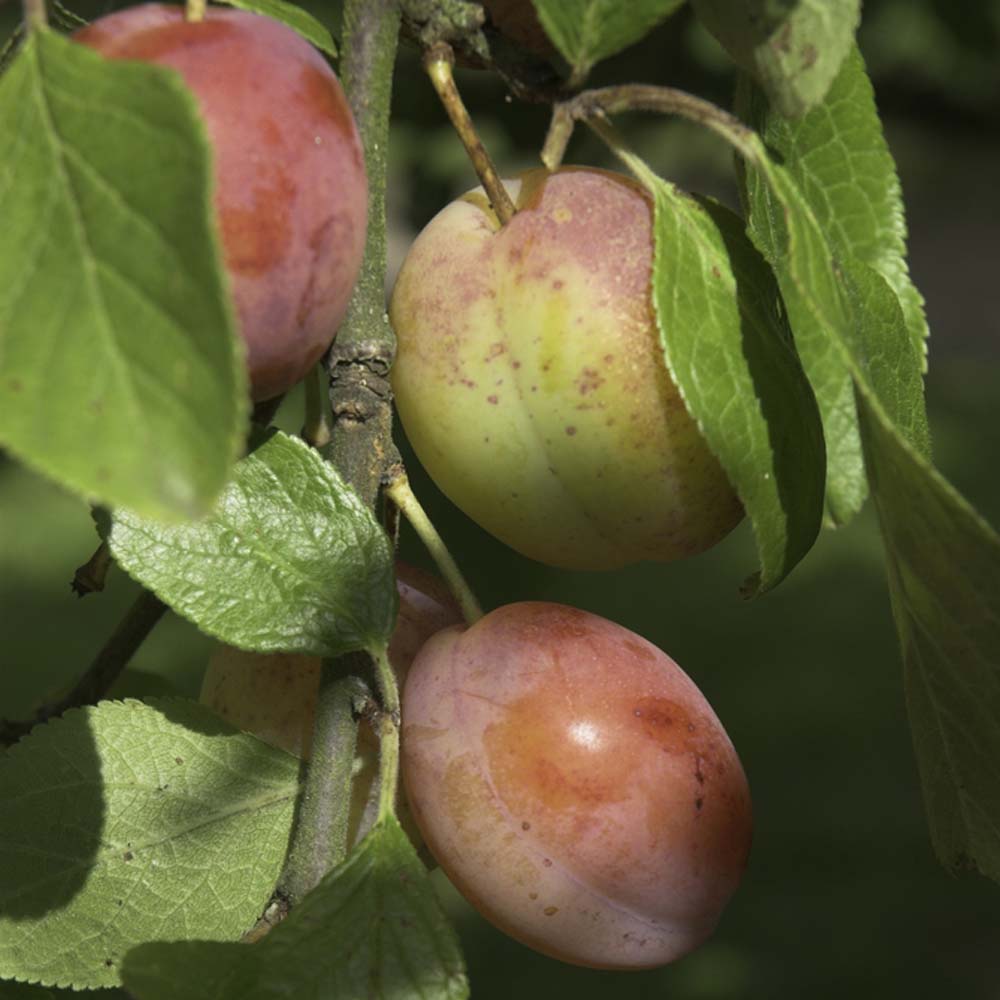
Reaching a mature height of 10m, Sorbus aucuparia is an excellent candidate for smaller gardens or areas with limited space. Often recognised for its pinnate leaves, clusters of creamy-white flowers and fantastic display of red/orange berries, the native Rowan tree is also valued for its attraction to wildlife!
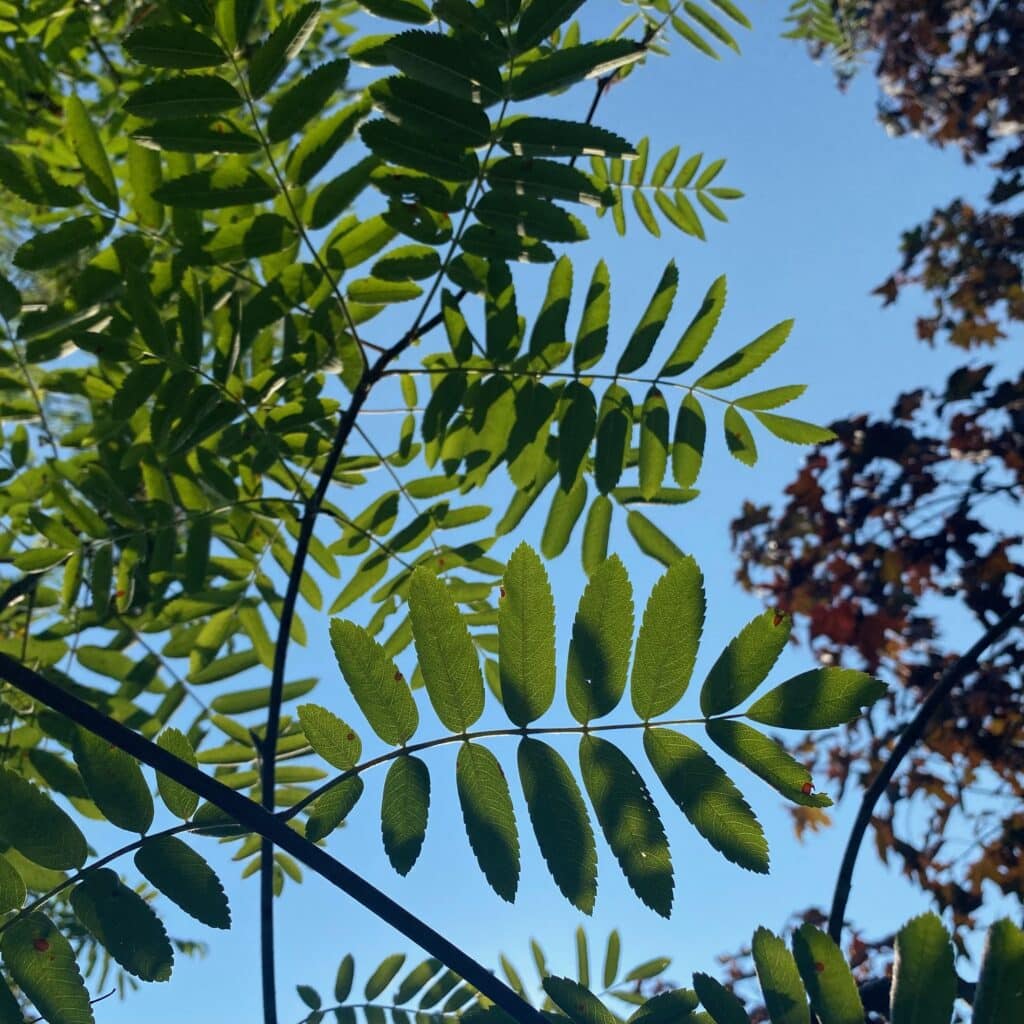
This small, deciduous tree has green leaves that emerge with a bronze tint in spring and turn to seasonal shades of orange and red in the autumn. In spring, the Juneberry tree also bears star-like, white flowers, these flowers are followed by dark purple berries in summer. Reaching a mature height of around 5m, the attractive appearance, multi-season interest and manageable size make this tree a popular choice for smaller gardens!
Planted for its seasonal interest, Amelanchier ‘Robin Hill’ has an upright form which makes it ideal for more compact gardens. Like Amelanchier lamarckii, this tree has green leaves that emerge with a bronze tint in spring. These turn to seasonal shades of orange and red in the autumn. ‘Robin Hill’ also bears white flowers that emerge from pink tinged buds in spring, these flowers are followed by dark purple berries in summer.
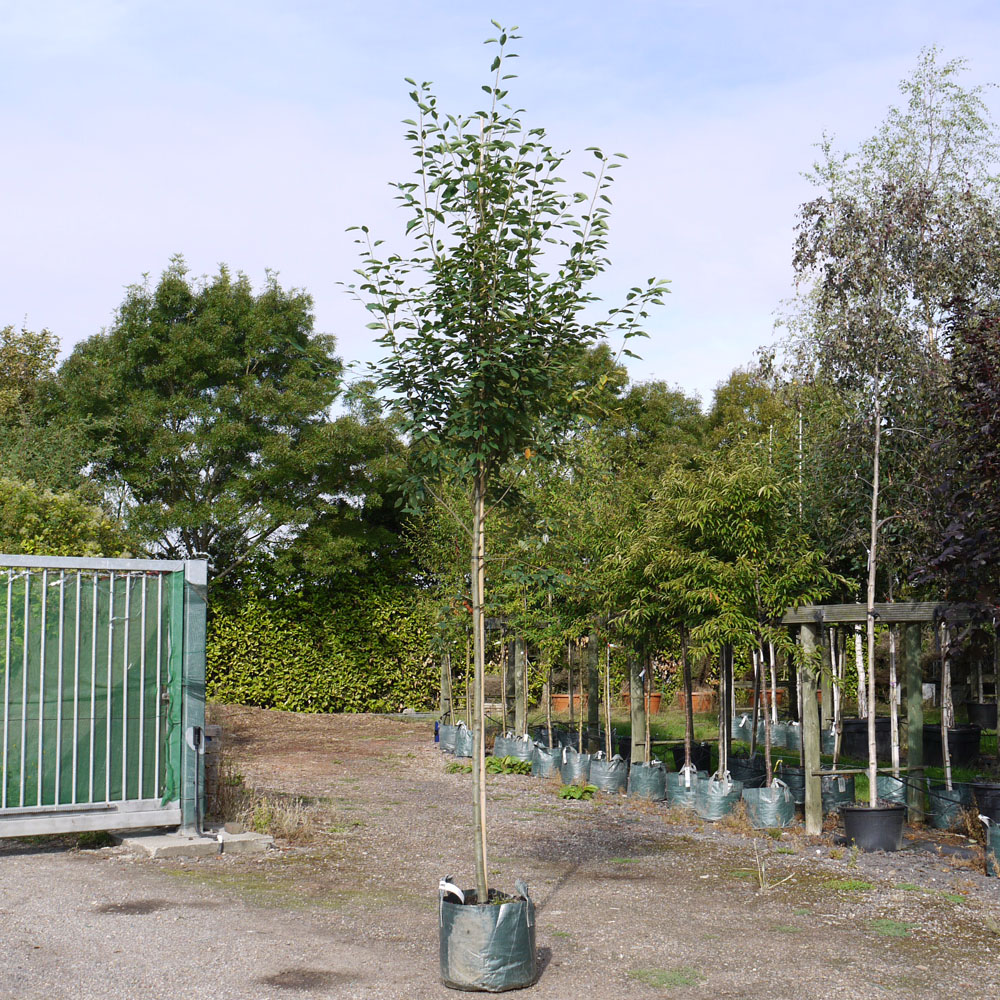
Container grown trees can be planted all year round. Watch our video guide on how to professionally plant and stake your tree!
As a guide, we recommend giving each tree 5 litres of water every other day during the growing season. The water should be directed at the base of the trunk.
5 Litres is a good starting point to make sure that the ground stays moist, if the soil starts to become saturated or dry adjust the amount as required.
We can offer our planting service if you are local to the nursery. Planting prices are dependent on the size of the pot. Please contact us if you would like a quote.
King and Co the Tree Nursery are RHS Chelsea Gold Medals winners and are Plant Healthy certified, here we detail how to plant a tree grown in a container. This guide is for tree planting using a double staking method. The Nursery has also produced a step-by-step video – watch it here.
Container grown trees can be planted all year round, unlike bare root and root-balled trees, which can only be planted during the planting season (November – March). Buy a container grown tree which has an already more established root system for a higher success rate.
Trees of this type are lighter and easier to manoeuvre, making it faster and easier to plant and get them to the planting site. King and Co can deliver container grown trees next-day nationwide due to their portable nature once packaged.
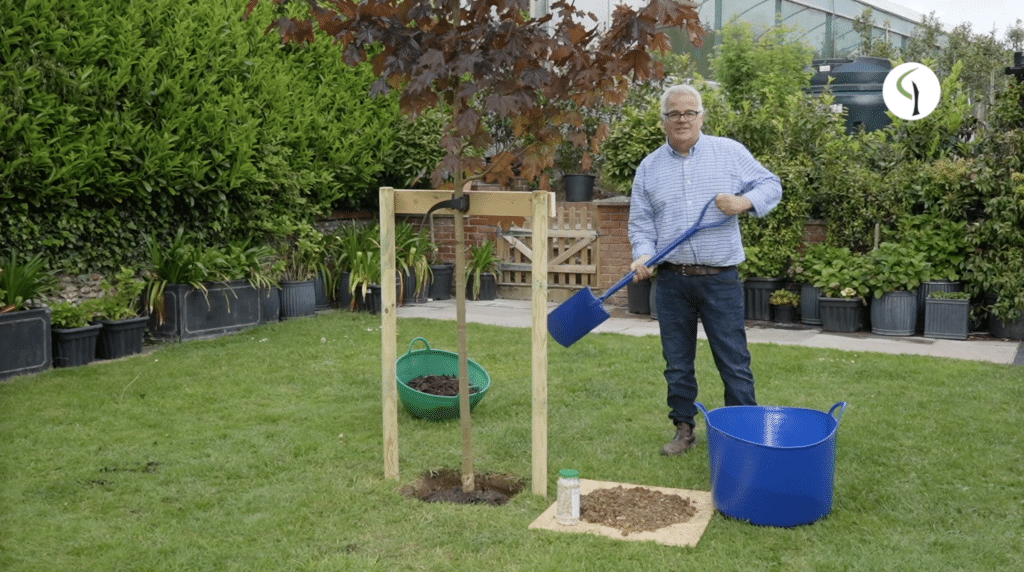
Also known as the planting pit, which should be around 25% wider than the rootball. It is important to only dig a few centimetres deeper than the rootball. If the tree is planted too deep, the tree suffocates and ultimately the tree fails. Keep your excavated soil to one side, ready for improvement later on.
Remove the tree from its container, or bag that it has been growing in. Place the tree carefully into the planting pit to check the depth. Just add or take away soil if required.
Tree staking is critical for planting success. Staking protects the roots whilst establishing, keeping the tree upright and stable. The stakes should be knocked in with a post driver or sledgehammer until they are held firmly in the ground. Use 30cm as a rough guide.
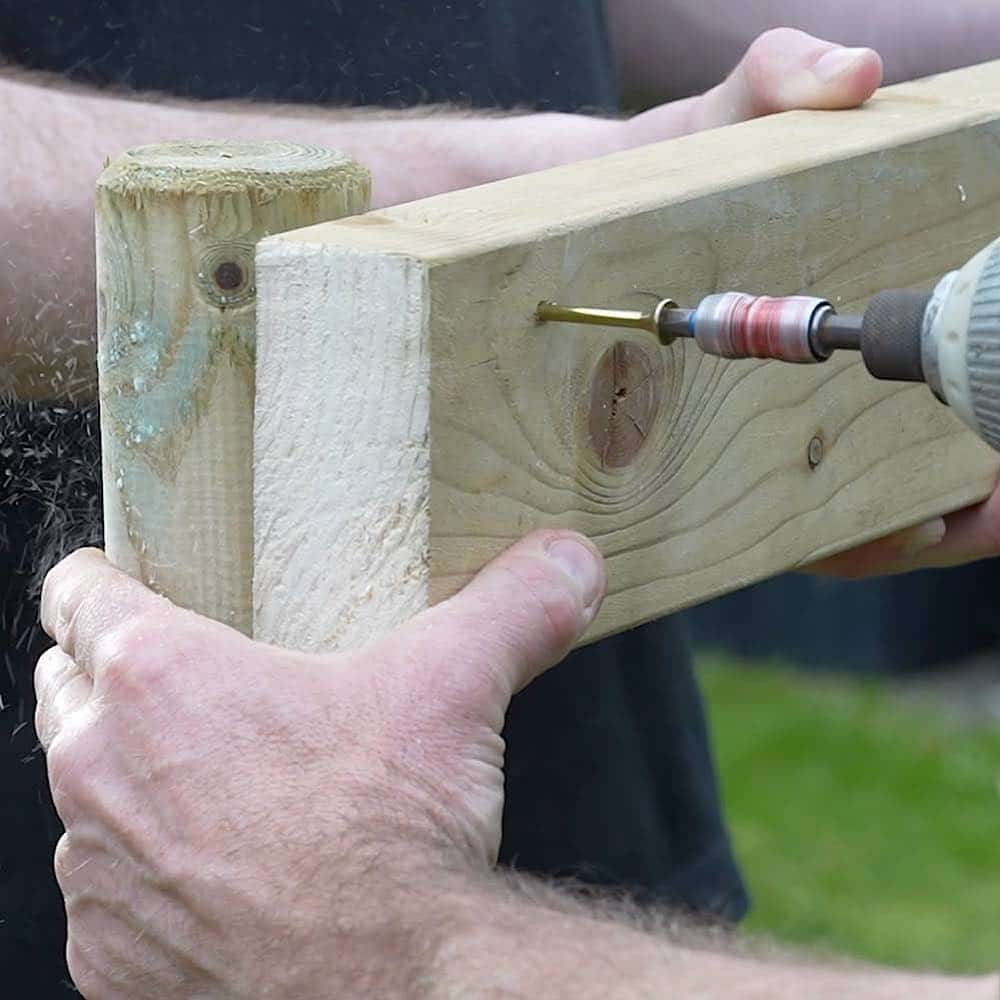
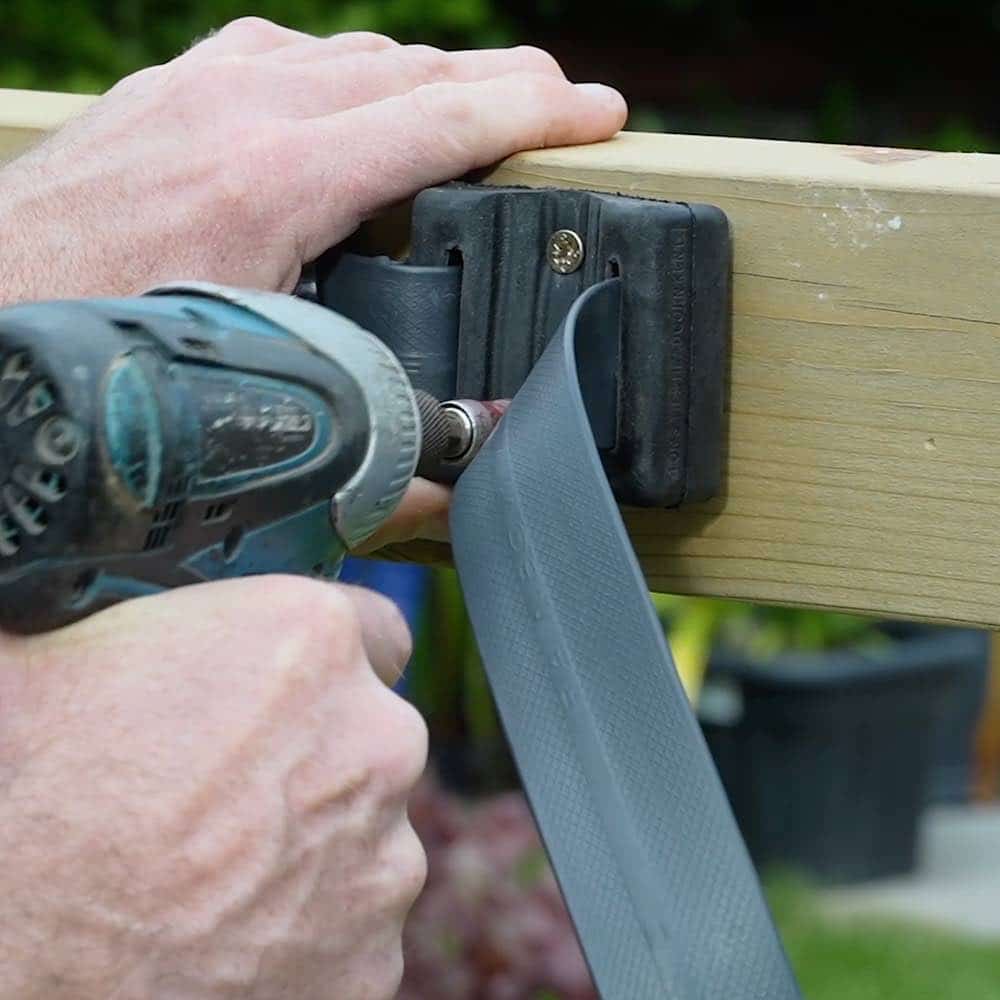
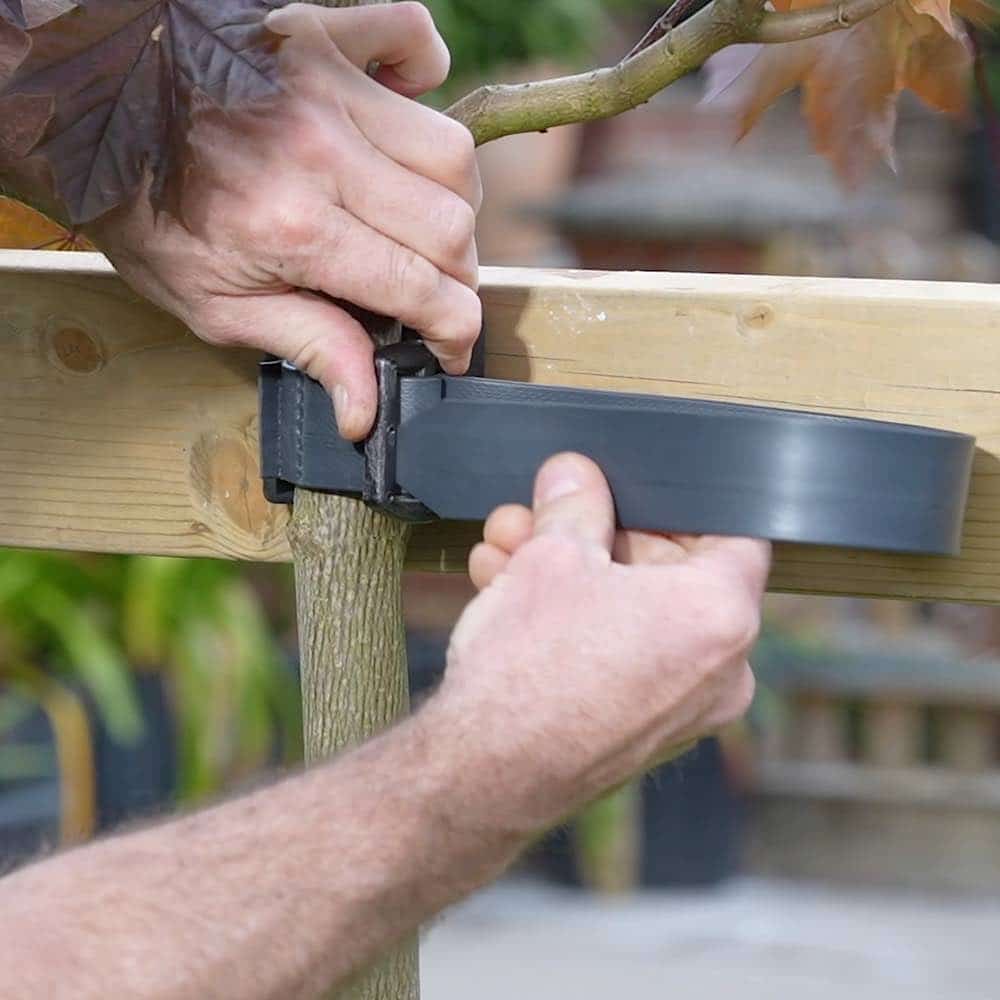
Measure your crossbar up against the two stakes and, whilst keeping it level, screw or nail it to each stake. Weave the buckle tie into the tree pad and screw this into the crossbar, move this left or right to ensure the tree is upright. Place the tree back inside the planting pit and secure using the buckle tie.
Help your newly planted tree by improving the soil quality. Mix your excavated soil with some multipurpose compost to help improve water retention and nutrient uptake. Incorporate some King and Co specialised Tree fertiliser to give your tree a real boost.
Backfill the planting pit with your newly improved soil, making sure to fill around the side of the rootball. Heel in the soil firmly to ensure good root and soil contact. Next, mulch around the base of the tree, which will help prevent weed growth and trap moisture.
Water in your new tree to help it settle. We recommend a couple of litres, every other day in the warm growing season. Watering the key to success, too much can be just as detrimental as not enough.
Prune any dead wood, and maintain a weed free area around the base of the tree. As the tree grows, you can loosen off the buckle tie to stop it damaging the stem.
If you need any more help or advice, get in contact with King and Co. Watch our video below for a demonstration of how to plant a tree grown in a container.
We’re proud to share that King and Co has successfully retained its Plant Healthy certification for another year. This achievement reflects our ongoing commitment to high standards in plant health and biosecurity. As a certified Plant Healthy nursery, retail, and trade outlet, we ensure that every tree and plant we supply is responsibly sourced, expertly grown, carefully handled and treated with the utmost care and respect to biosecurity.
The Plant Healthy scheme plays a vital role in protecting the horticultural industry, cultivated plants, and natural habitats. It does this by reducing the risk of introducing and spreading destructive plant pests throughout the supply chain. Supply tenders for tree and hedge planting projects increasingly require suppliers to hold this certification!
At King and Co, we stay in regular contact with DEFRA and APHA to remain fully aligned with current plant health regulations. For example, we closely monitor and respond to Oak Processionary Moth (OPM) movement restrictions, which currently impact areas like London and Essex. Because of this proactive approach, we can dynamically ensure our trees, plants, and garden centre materials are protected, which means our customers receive healthy trees and shrubs.
The scheme reviews every step of our process, from grower to garden. Our certification isn’t just a checkbox, it reflects a voluntary commitment to following the horticultural industry’s best practices!
View King and Co’s Plant Healthy Certificate of Conformity for 2023-24 here.

How to Plant Bare Root Hedging and Trees: A Beginners Guide
Take a look at our recent project where we used Pleached Photinia Red Robin to boost privacy in a new build garden. Photinia Red Robin is one of our favourite evergreen varieties, so this garden will have year-round coverage and privacy, even in winter.
Pleached trees are a great choice for enhancing privacy because their foliage has been grown for several years to cover a trellis frame, this creates an immediate screening effect! Just like our other screening trees, pleached trees typically feature a clear stem of 1.8m, with most frames measuring 1.2m x 1.2m. This lets you enjoy the privacy benefits of a hedge without sacrificing valuable garden space.
The above image showcases a recent planting project featuring Pleached Photinia trees with 1.8m clear stems and 1.2m x 1.2m frameworks. As you can see, these pleached trees were perfect for planting against our customers standard 6ft fence panel. This design not only created an elegant, stilted hedge that sits beautifully above their fence line, but also provides them with ample time for planning an under-planting scheme. Planting Photinia Red Robin was also a clever way to add seasonal interest, as its foliage emerges as a striking red in the spring before maturing to a deep, lush green!

The Tree Nursery in Rayne, Essex (less than an hour from London) is open to the public Monday-Friday from 9am to 4pm. With over 2000 products on site, our sales team can advise on the most appropriate trees or plants to use in your garden. We can also conduct this over email, and are able to dispatch trees and plants next-day nationwide!
We also stock pleached Cherry laurel and Hornbeam with 1.5 x 1.2m frames. If you’re seeking an alternative to Photinia, Cherry laurel (Prunus laurocerasus) is another evergreen variety that offers year-round coverage. Alternatively, if you prefer more natural light during the winter, Hornbeam is a great deciduous option. While Hornbeam is deciduous, it retains its brown leaves well into the winter, allowing light to filter through while still providing some coverage!
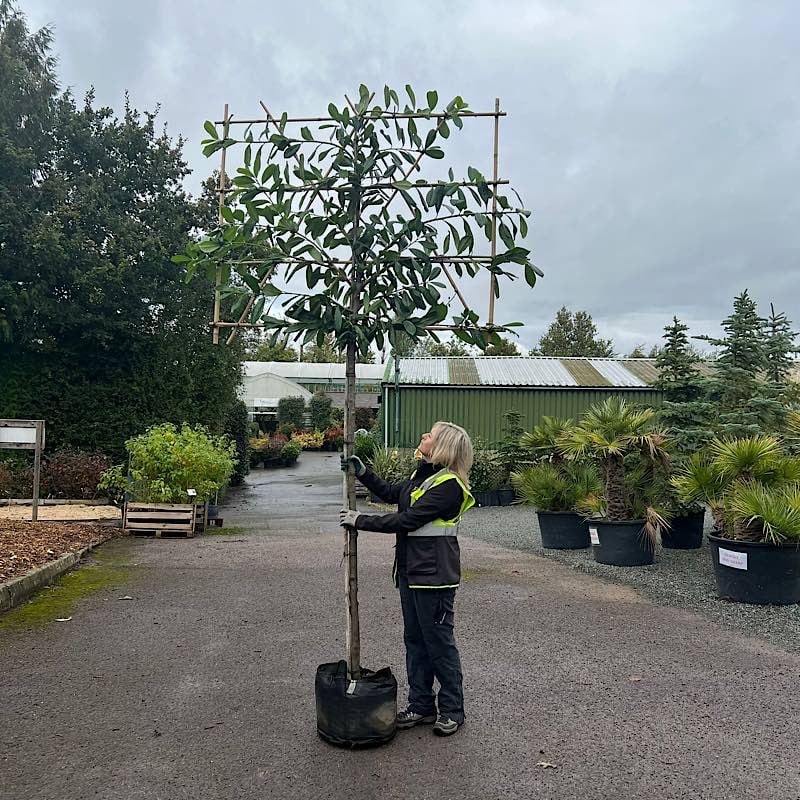
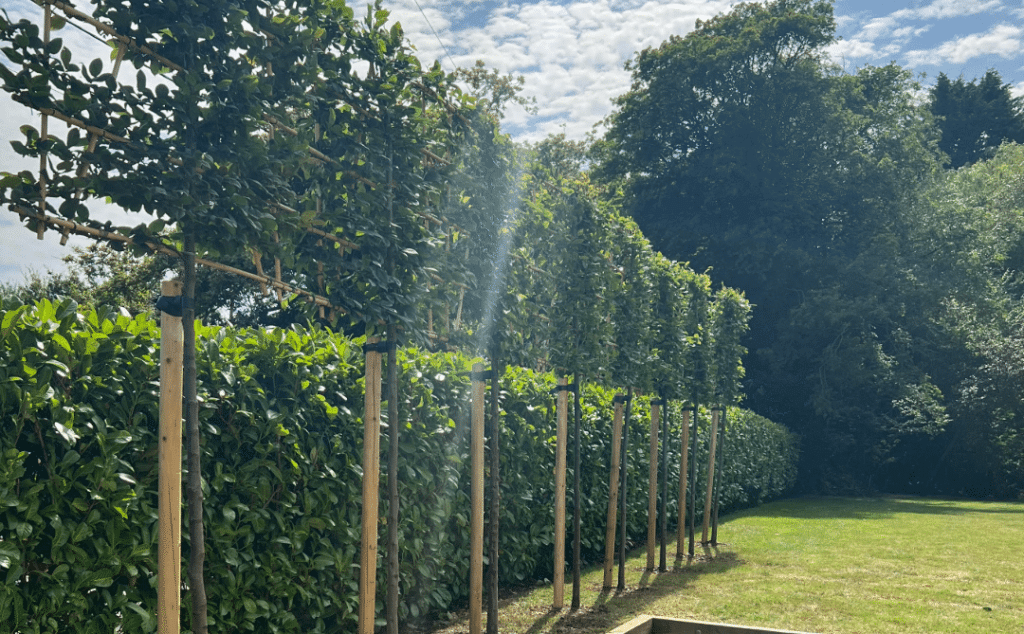
Check out our related posts:
You can buy trees, hedging, shrubs and topiary online by browsing our website.
If you do not see a plant or size that is suitable for you then please call as we stock a wide variety of plants in our tree nursery. It’s worth noting that many other websites sell other people’s stock (i.e. they act as an agent) so you cannot view the products at their own site. At King & Co, all of our advertised plants are available for viewing at our tree nursery in Rayne, near Braintree, situated just over an hours drive out of London.
Our knowledgeable and experienced tree nursery staff are always contactable via phone on 01376 340469 or if you have any questions regarding any of our trees or accessories.
If you cannot see what you require on our website, please complete the enquiry form. We will give it our urgent attention and will get back to you shortly with a solution that meets your needs.
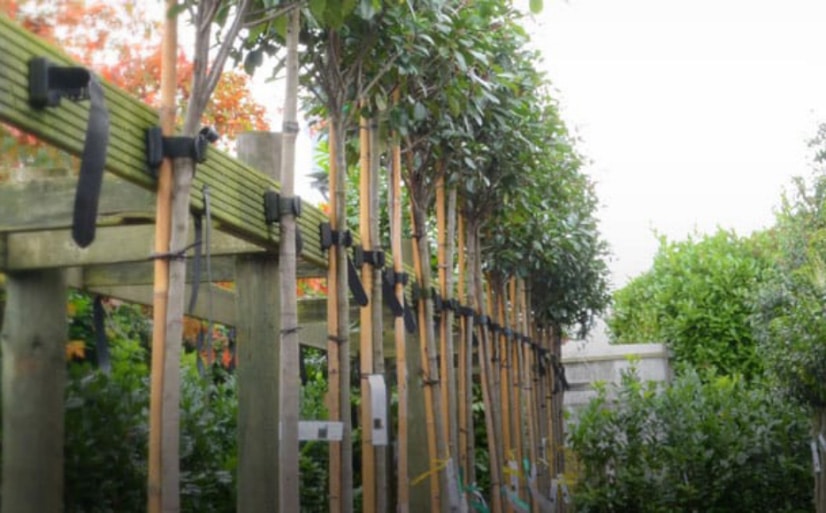
If you are looking for specific evergreen trees, Photinia, Leylandii hedging, Leylandii trees, instant hedging or shrubs, use the search bar at the top of the page